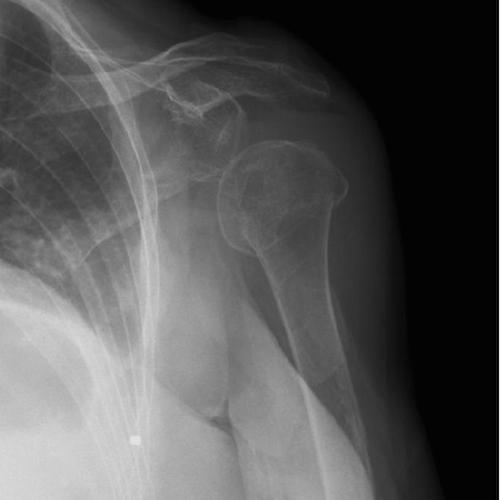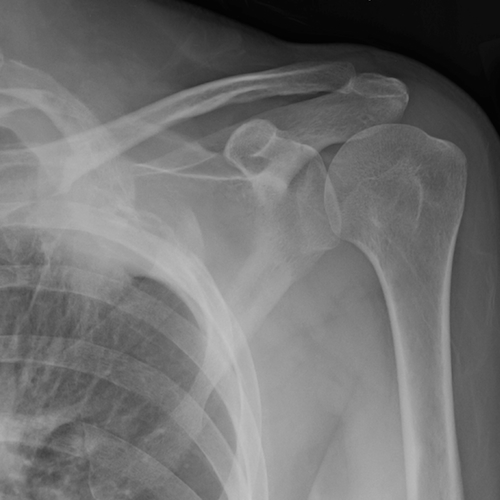
Systematic review
Glenohumeral joint

- articular surfaces should be parallel
- the humeral head should on the glenoid on any other view
- if the humeral head lies under the coracoid process, think anterior shoulder dislocation
- if there is a joint effusion, think humeral head or glenoid fracture
Acromioclavicular joint

- the inferior borders of distal clavicle and acromion should line up
-
if there is a step, think ACJ injury
- AC distance > 8 mm: AC ligament rupture
- CC distance > 13 mm: CC ligament rupture
Bony cortex

- cortex should be smooth smooth
- the humeral head
- glenoid fossa
- clavicle
- body of scapula
- look for fracture fragments
- remember the ribs
Common pathology
Anterior shoulder dislocation

- 95% of all shoulder dislocations
- young males and the elderly
- forced abduction, external rotation and extension
- humeral head lies anterior, medial and inferior to glenoid fossa
- common associated fractures:
- Hill-Sachs lesion
- Bankart lesion
- more: anterior shoulder dislocation
Clavicle fracture

- up to 10% of all fractures
- predominantly midshaft
- mostly children and the elderly
- fall onto outstretched hand or shoulder
- more: clavicle fracture
Acromioclavicular joint injury

- very common injury
- range from strain to complete joint disruption
- direct blow or fall onto shoulder with adducted arm
- step at AC joint, widening of AC joint and/or increased CC distance
- more: acromioclavicular joint injury
Proximal humeral fracture

- common injury resulting in significant disability
- elderly females: mean age 65 years
- fall on an outstretched arm
- more: proximal humeral fracture
Don't miss
Posterior shoulder dislocation

- less than 5% of glenohumeral dislocations but often overlooked
- common in adults following a seizure or in the elderly
- humeral head forced posteriorly in internal rotation whilst arm is abducted
- classically, the humeral head is rounded on AP - light bulb sign
- associated with anteromedial fracture of humeral head
- more: posterior shoulder dislocation
Shoulder pseudosubluxation

- usually secondary to trauma
- an effusion or hemorrhage into the joint displaces the humeral head inferiorly
- this effusion suggests intra-articular fracture
- do not confuse with dislocation!
- more: shoulder pseudosubluxation
Pancoast tumor

- primary bronchogenic carcinoma arising in lung apex
- account for up to 5% of all bronchogenic cancers
- always review lung parenchyma, ribs and supraclavicular fossa in AP shoulder radiographs
- more: Pancoast tumor







 Unable to process the form. Check for errors and try again.
Unable to process the form. Check for errors and try again.